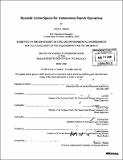| dc.contributor.advisor | Liyi Dai, Lance A. Page and Nicholas Roy. | en_US |
| dc.contributor.author | Earnest, Caleb A | en_US |
| dc.contributor.other | Massachusetts Institute of Technology. Dept. of Civil and Environmental Engineering. | en_US |
| dc.date.accessioned | 2009-08-26T16:48:41Z | |
| dc.date.available | 2009-08-26T16:48:41Z | |
| dc.date.copyright | 2005 | en_US |
| dc.date.issued | 2005 | en_US |
| dc.identifier.uri | http://hdl.handle.net/1721.1/46549 | |
| dc.description | Thesis (S.M.)--Massachusetts Institute of Technology, Dept. of Civil and Environmental Engineering, 2005. | en_US |
| dc.description | Includes bibliographical references (p. 148-150). | en_US |
| dc.description.abstract | This thesis presents a new approach for a Navy unmanned undersea vehicle (UUV) to search for and detect an evading contact. This approach uses a contact position distribution from a generic particle filter to estimate the state of a single moving contact and to plan the path that minimizes the uncertainty in the location of the contact. The search algorithms introduced in this thesis will implement a motion planner that searches for a contact with the following information available to the decision system: (1) null measurement (i.e., contact not detected at current time), (2) timedated measurement (i.e., clue found at current time that indicates contact was at this location in the past), and (3) bearings measurement (i.e., angular measurement towards contact position detected at current time). The results of this thesis will be arrived at by evaluating the best methods to utilize the three types of information. The underlying distribution of the contact state space will be modeled using a generic particle filter, due to the highly non-Gaussian distributions that result from the conditions mentioned above. Using the particle filter distribution and the measurements acquired from the three conditions, this thesis will work towards implementing a path planning algorithm that creates dynamic action spaces that evaluate the uncertainty of position distribution. Ultimately, the path planner will choose the path that contains the position distribution and leads to sustained searches. | en_US |
| dc.description.statementofresponsibility | by Caleb A. Earnest. | en_US |
| dc.format.extent | 150 p. | en_US |
| dc.language.iso | eng | en_US |
| dc.publisher | Massachusetts Institute of Technology | en_US |
| dc.rights | M.I.T. theses are protected by
copyright. They may be viewed from this source for any purpose, but
reproduction or distribution in any format is prohibited without written
permission. See provided URL for inquiries about permission. | en_US |
| dc.rights.uri | http://dspace.mit.edu/handle/1721.1/7582 | en_US |
| dc.subject | Civil and Environmental Engineering. | en_US |
| dc.title | Dynamic action spaces for autonomous search operations | en_US |
| dc.type | Thesis | en_US |
| dc.description.degree | S.M. | en_US |
| dc.contributor.department | Massachusetts Institute of Technology. Department of Civil and Environmental Engineering | |
| dc.identifier.oclc | 419330890 | en_US |
